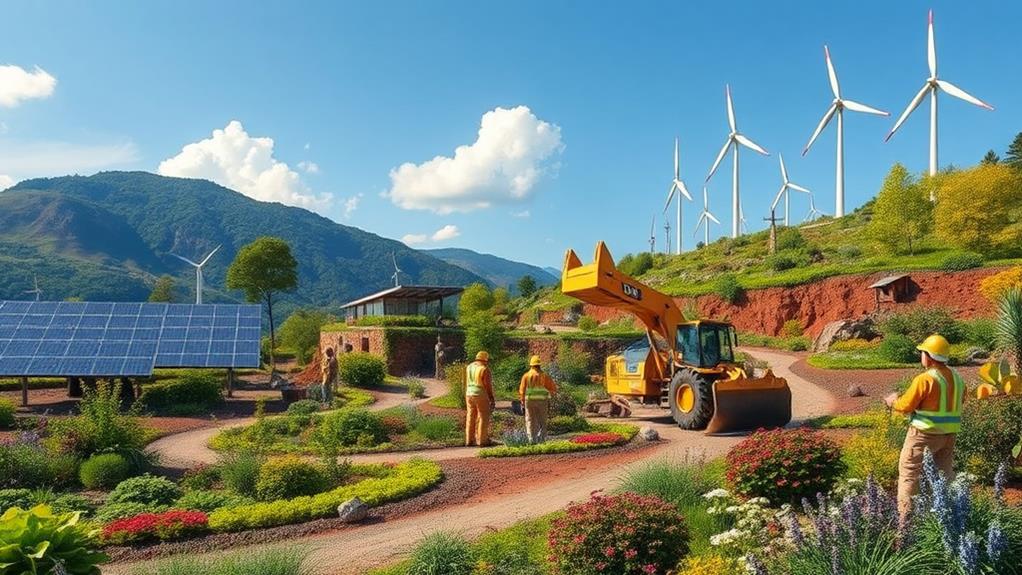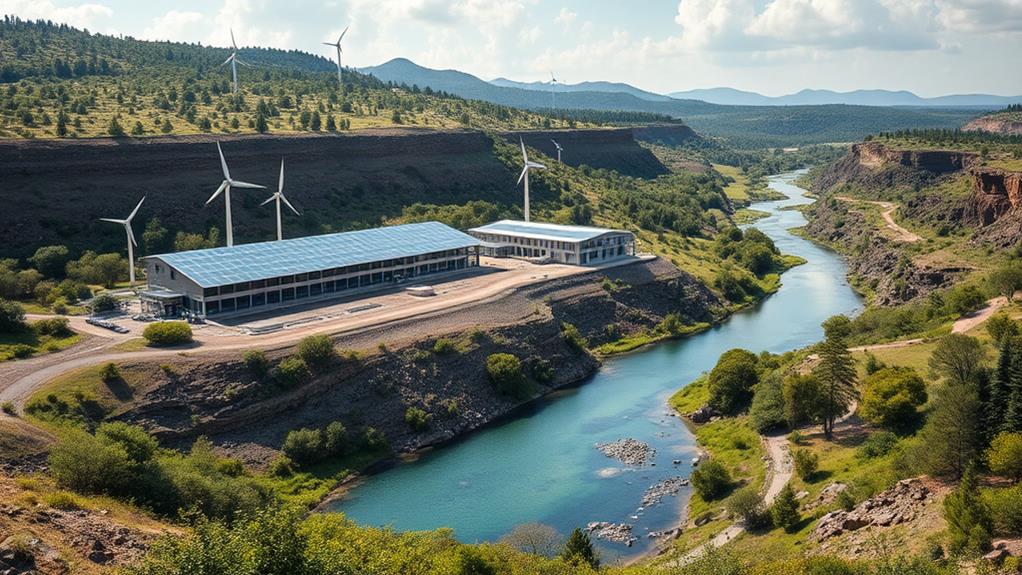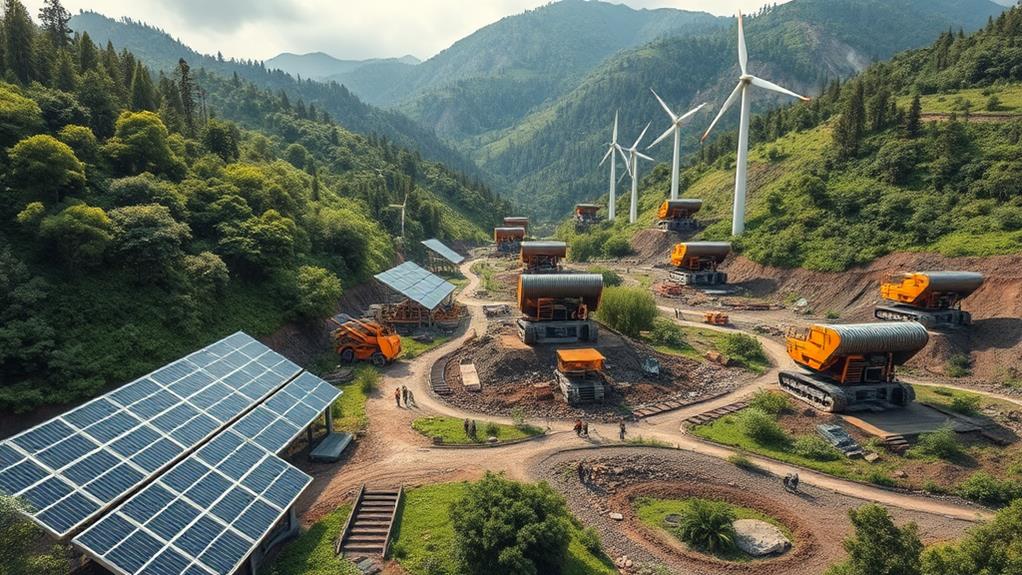Sustainable mining practices are essential for balancing economic growth with environmental protection. By using innovative technologies, mining companies can cut water usage by up to 50% and adopt zero-waste practices to reduce waste.
These methods not only create local job opportunities but also help develop stronger community relationships and support healthier ecosystems.
Despite these advancements, challenges remain, including soil erosion and water pollution. To address these issues, strong governance and regulatory frameworks are needed.
Collaboration among all stakeholders, such as companies, governments, and communities, can enhance these sustainable practices and ensure that economic benefits are shared fairly.
As you examine these practices, you will find successful case studies that illustrate how they work and future trends that will shape a more sustainable mining industry.
Importance of Sustainable Mining

Sustainable mining is crucial in today's world because it helps protect the environment and supports local communities. By using new technologies, like waterless systems and zero-waste practices, mining companies can reduce pollution and make better use of resources. For example, instead of using large amounts of water, some mines are now using dry methods to cut down on water waste.
Sustainable mining also improves relationships with local communities. This happens because companies that practice sustainable mining often engage with community members and respect their rights and cultures. As a result, local people benefit from mining jobs and investments, which can lead to more job opportunities in the area.
Moreover, responsible waste management and pollution control lead to healthier ecosystems. Research shows that companies that invest in sustainable practices often have lower carbon dioxide (CO2) emissions.
This means that focusing on long-term strategies is better for the environment than just chasing quick profits. In a world where environmental issues are becoming more important, sustainable mining can help solve these problems and position the mining industry as a leader in responsible resource extraction.
Economic Impacts of Mining
Mining is very important for economic growth, especially in developing countries. It helps create jobs and generates tax revenue for local and national governments.
However, the benefits aren't shared equally among mining communities, which can lead to problems.
Job creation in mining is significant, but many of these jobs are low-skilled and depend on changing mineral prices. This means that workers may face job insecurity.
Additionally, revenue distribution often doesn't support local communities enough, which can increase poverty and cause social unrest.
Switching to sustainable mining practices can improve social benefits. This means ensuring local communities receive a fair share of mining revenues and protecting the environment.
By focusing on sustainability, mining can provide long-term advantages for everyone involved.
In summary, while mining contributes to economic growth, it's important to address its negative effects on the environment and local communities.
Sustainable practices can help create better jobs and improve living conditions for mining communities.
Environmental Challenges in Mining

Mining activities create serious environmental challenges that affect ecosystems and local communities. For example, mining can cause soil erosion, which removes the top layer of soil necessary for plants to grow. It also leads to deforestation where trees are cut down, disrupting habitats for many animals. Additionally, water pollution occurs when harmful chemicals from mining operations contaminate rivers and lakes, making water unsafe for drinking and harming fish and other aquatic life.
One major concern is the disposal of tailings, which are leftover materials from mining. Some mines produce over 200,000 tonnes of tailings every day, posing a risk of contaminating soil and water resources.
| Environmental Issue | Impact on Communities |
|---|---|
| Water Pollution | Affects drinking water quality and aquatic life |
| Acid Mine Drainage (AMD) | Harms ecosystems and requires continuous treatment |
| Waste Management | Poor practices lead to increased environmental hazards |
Another problem is acid mine drainage (AMD), which happens when water mixes with sulfur and creates acid. This acid can destroy fish habitats and requires constant treatment to keep the water safe. Although mining can bring in economic benefits, the use of advanced extraction technologies can worsen environmental damage. This damage often outweighs the benefits for local communities.
To lessen these negative effects, responsible waste management and sustainable practices are essential. By adopting these strategies, communities can help ensure that economic growth does not come at the expense of environmental health, allowing both ecosystems and people to thrive.
Innovative Technologies in Mining
Innovative technologies are essential for making the mining industry more sustainable. These technologies help reduce the negative effects of mining on the environment. For example, waterless and zero-waste mining methods use fewer resources and create less waste. Closed-loop water systems, which aim for zero liquid discharge, are designed to use less freshwater and protect local water sources.
Information and communication technology (ICT) solutions can also help. These technologies have already shown they can cut CO2 emissions by 0.50%. This indicates their potential to improve sustainability in mining.
Advanced extraction methods are being developed to lower environmental impact and increase efficiency. Research on tailings, the leftover materials from mining, during early project studies is important. This research helps find ways to manage tailings better and reduce future risks.
Circular Economy Principles

Circular economy principles are essential for making the mining industry more sustainable. These principles help to reduce waste and recycle materials, which lowers the negative impact on the environment. For example, the Elikhulu Plant re-treats tailings to recover valuable minerals from old waste, demonstrating how effective these principles can be.
Another important step is using closed-loop water systems. These systems aim for zero liquid discharge, which greatly reduces the amount of freshwater needed and helps fight water pollution.
Additionally, innovative technologies, such as waterless mining methods, can significantly decrease the environmental harm caused by traditional mining practices.
By focusing on circular economy principles, the mining sector can't only address environmental issues but also promote sustainable economic growth.
Using resources efficiently extends the life and value of minerals, leading to a stronger economy. When mining operations adopt these practices, they create a balance between making profits and protecting the environment, ensuring a responsible future for the industry.
Community Engagement and Benefits
Mining operations that use circular economy principles must focus on community engagement to create a positive impact. Engaging with communities during all stages of mining—from exploration to closure—can lead to better social and environmental outcomes.
Building partnerships between mining companies and local communities helps address their real concerns, which can improve infrastructure and social responsibility.
Benefits of strong community engagement include:
- More local jobs, which support sustainable mining practices. For example, mining companies can hire locals for various roles, reducing unemployment.
- Fair sharing of mining profits, which helps reduce poverty and social unrest. This could mean that a portion of mining profits goes directly to community projects, like schools or health clinics.
- Ongoing monitoring of social effects to ensure that mining contributes positively to local economies. This might involve regular surveys and community meetings to assess the social impact.
Artisanal mining is important for many local people but often poses safety risks. Community welfare programs are essential to protect workers and their families.
Sustainable mining practices should focus on benefiting the community and the environment. When companies establish strong partnerships with locals, they can improve relationships and support community development, leading to economic growth.
Engaging with local populations ensures that mining benefits everyone involved, creating a fairer and more sustainable future.
Regulatory Frameworks and Governance

Effective regulatory frameworks and governance are essential for sustainable mining. Without these, mining activities can lead to environmental damage and social issues. For example, in some countries, weak laws allow profits to go to a few wealthy people, while local communities face problems like pollution and loss of land.
Community consultation is important, but it's often ignored. This can create tension between mining companies and local residents. For instance, when companies fail to talk to communities before starting projects, people may feel their needs and concerns aren't valued.
Open discussions can help ensure that communities are involved in decision-making, leading to better outcomes for everyone.
Many existing mining laws have weak penalties for violations and aren't enforced well. To fix this, strong governance structures are needed. These should focus on protecting the environment and promoting practices that help both companies and local people.
Case Studies of Successful Practices
Regulatory frameworks and community involvement are essential for sustainable mining practices. Innovative technologies and effective water management can greatly improve sustainability in the mining industry.
For example, the Elikhulu solar plant in South Africa uses renewable energy, which reduces carbon emissions in mining operations. Another example is waterless mining technologies, which have cut water usage by 30%, showing their effectiveness in lowering environmental impact.
Similarly, in Australia, closed-loop water systems have decreased freshwater consumption by 50%, demonstrating successful water management practices.
These examples show that companies focused on resource efficiency and community involvement can enhance sustainability and improve social outcomes. Engaging local communities in decision-making and sharing benefits helps build trust and reduces conflicts.
Additionally, tailings re-treatment processes at the Elikhulu Plant recycle minerals from old waste, further decreasing environmental harm.
How Can Sustainable Mining Practices Help Reduce Industrial Pollution?
Sustainable mining practices can significantly reduce industrial pollution impacts manufacturing and mining. By using eco-friendly technologies and implementing proper waste management, mining companies can minimize air and water pollution, ultimately helping to protect the environment and surrounding communities from the detrimental effects of industrial pollution.
Future Trends in Sustainable Mining

The future of sustainable mining is changing as companies use new technologies and methods. Waterless and zero-waste mining are examples of practices that reduce the environmental harm caused by traditional mining. This change is happening because mining companies want to improve their Environmental, Social, and Governance (ESG) performance, which helps them meet the demands of investors who want responsible resource management.
Renewable energy, like solar power, is becoming an important part of mining operations. For instance, the Elikhulu solar plant shows how using cleaner energy can lower carbon emissions in the industry.
Additionally, public-private partnerships are being created to increase community benefits while protecting the environment in areas that rely on mining.
There is also a trend towards using sustainability measurement frameworks, such as the GRI Sustainability Reporting Guidelines. These frameworks help mining companies be more transparent and accountable, making it easier for stakeholders to evaluate their ESG performance.
Collaboration for Sustainable Solutions
Collaboration is essential for creating sustainable mining solutions. In mining, the collaboration between governments, mining companies, and local communities can lead to positive changes. For example, when these groups work together, they can create public-private partnerships that improve local infrastructure, like roads and schools.
Effective stakeholder engagement is critical. This means listening to and respecting the rights and cultural heritage of local communities. For instance, addressing concerns about land use and ensuring post-closure rehabilitation of mining sites can help communities feel supported.
Capacity building is important for better outcomes. This involves training and education for local communities to help them manage resources effectively. The Intergovernmental Forum on Mining stresses that working together leads to better social and environmental results.
To promote sustainable mining practices, specific strategies are needed. These include improving financial management, using new technological advancements, and enhancing governance. Together, these strategies encourage inclusive development that benefits both the economy and the environment.
- Promote public-private partnerships to improve local infrastructure.
- Engage stakeholders consistently to address community concerns.
- Focus on capacity building to enhance governance and social outcomes.
Questions and Answers
How to Balance Economic Growth and Environmental Sustainability?
To balance economic growth and environmental sustainability, we can use several strategies. First, we should leverage technological innovation. For example, using solar panels and wind turbines can create clean energy that helps the economy while protecting the environment.
Second, enforcing regulatory frameworks is important. Laws that limit pollution from factories ensure that businesses operate responsibly. This can lead to cleaner air and water for everyone.
Third, we can promote sustainable investments. Investing in green companies that focus on eco-friendly products can lead to job creation and environmental benefits.
Fourth, fostering community involvement is key. Local groups can participate in conservation projects, such as tree planting, which helps the environment and brings people together.
Fifth, we need to ensure corporate responsibility. Companies should adopt practices that reduce waste and energy use, like recycling programs and energy-efficient appliances.
Finally, we should encourage stakeholder collaboration. Governments, businesses, and communities can work together to create plans that support both growth and sustainability.
What Mining Practices Are Utilized to Protect the Environment?
To protect the environment in mining, reclamation techniques are used. This means restoring the land after mining is done. For example, companies can fill in holes left by mining with soil and plant trees to help the area recover.
Effective waste management is also important. This involves handling waste materials properly to prevent pollution. For instance, using special containers for hazardous waste reduces the risk of it contaminating nearby water sources.
Another key practice is water conservation. This includes methods like recycling water used in mining processes. For example, some mines treat and reuse water instead of drawing new water from rivers or lakes.
Engaging with communities is crucial. Mining companies often work with local residents to understand their concerns. This can lead to better practices that benefit both the company and the community.
Promoting biodiversity protection is necessary too. This means taking steps to protect plants and animals in the mining area. For example, creating wildlife corridors can help animals move safely around mining sites.
Finally, using renewable energy sources, like solar or wind power, helps reduce pollution. This shift can lower the carbon footprint of mining operations.
These practices together help ensure that mining can be done in a way that is safer for the environment.
How Can Mining Be More Environmentally Sustainable?
Mining can be made more environmentally sustainable by focusing on several key areas. Recycling materials is important because it reduces the need for new mining. For example, recycling aluminum cans saves energy and resources compared to mining new aluminum.
Effective water management is also essential. Mining uses a lot of water, so recycling water used in the process helps conserve this resource. For instance, some mines treat and reuse water for dust control and processing.
Habitat restoration involves returning mined areas to their natural state. This can include planting trees and restoring local wildlife habitats after mining has stopped.
Using renewable energy sources, like solar or wind power, can lower the carbon footprint of mining operations. For example, some mines are now using solar panels to power their facilities.
It is crucial to prioritize waste reduction. Implementing better waste management practices can lead to less harmful waste being produced.
Biodiversity preservation is also vital. Protecting local species and ecosystems during mining activities helps maintain a healthy environment.
Community engagement is important for ensuring local populations are involved in decision-making. This can lead to better outcomes for both the community and the environment.
Finally, regulatory compliance ensures that mining companies follow laws and regulations designed to protect the environment. Following these rules helps minimize negative impacts.
How Does Environmental Protection Help the Economy?
Environmental protection helps the economy by improving resource management and creating jobs. For example, when we focus on keeping our air and water clean, businesses can operate more efficiently, which can lead to cost savings. Creating green jobs is also a direct benefit. Jobs in renewable energy, like solar and wind, are growing rapidly.
Community involvement is another advantage. When people work together on environmental projects, it builds a stronger community. Stronger regulations are important too. They ensure that businesses follow practices that are good for the environment, which can lead to sustainable growth.
Renewable resources are crucial for the future. Using solar panels or wind turbines reduces our reliance on fossil fuels. This not only helps the planet but also opens up new markets and opportunities for innovation.